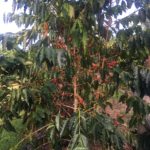
The U.S. Environmental Protection Agency (EPA) has approved a request from the Hawai`i Department of Agriculture (HDOA) to allow the use of a specific fungicide to help coffee farmers manage and control the coffee leaf rust (CLR).
The fungicide, Priaxor® Xemium, is not currently labeled by the EPA for specific use on coffee plants, but it is allowed for use to control fungi on leafy vegetables, strawberries, tomatoes, soybeans, wheat and many other crops. In March 2021, HDOA filed a request for a specific exemption with the EPA to allow the use of the fungicide on coffee plants. HDOA was notified of the approval of the emergency exemption yesterday which allows the fungicide to be used for up to one year or until use on coffee plants is added to the product label by EPA and the product’s producer.
In a press release Phyllis Shimabukuro-Geiser, chairperson of the Hawai`i Board of Agriculture, said, “Hawai`i coffee growers now have an added method to combat the coffee leaf rust which is extremely difficult to manage. Other efforts to minimize the damage and spread of coffee leaf rust include quarantines on the movement of coffee plants and associated material, the import of disease-resistant coffee plants and the development of integrated pest management strategies.”
The EPA exemption allows coffee growers to use the fungicide under the following conditions:
- Growers must inform the Pesticides Branch at least seven days prior to using the product by emailing sec18@hawaii.gov.
- Personal protective equipment must be worn as required by the label.
- All directions on both the container label, as well as the dealer provided Section 18 label, must be followed.
- All use/application must be reported to HDOA’s Pesticides Branch within 10 days of application.
CLR is a coffee pathogen that was first discovered in Sri Lanka in 1869 and can cause severe defoliation of coffee plants resulting in greatly reduced photosynthetic capacity.